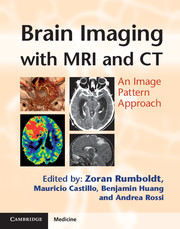Book contents
- Frontmatter
- Contents
- List of contributors
- List of abbreviations
- Preface
- Section 1 Bilateral Predominantly Symmetric Abnormalities
- Section 2 Sellar, Perisellar and Midline Lesions
- 38 Rathke's Cleft Cyst
- 39 Pituitary Microadenoma
- 40 Lymphocytic Hypophysitis
- 41 Pituitary Macroadenoma
- 42 Ectopic Posterior Pituitary Lobe
- 43 Langerhans Cell Histiocytosis
- 44 Craniopharyngioma
- 45 Hypothalamic Hamartoma
- 46 Optic Glioma
- 47 Perisellar Meningioma
- 48 Hemangioma of the Cavernous Sinus
- 49 Tolosa–Hunt Syndrome
- 50 Carotid-Cavernous Sinus Fistula
- 51 Perisellar Aneurysm
- 52 Chordoma
- 53 Chondrosarcoma
- 54 Colloid Cyst
- 55 Aqueductal Stenosis
- 56 Progressive Supranuclear Palsy (PSP)
- 57 Joubert Syndrome
- 58 Rhombencephalosynapsis
- 59 Multiple System Atrophy (MSA)
- 60 Maple Syrup Urine Disease (MSUD)
- 61 Chiari 2 Malformation
- 62 Tectal Glioma
- 63 Brainstem Glioma
- 64 Duret Hemorrhage
- 65 Hypertrophic Olivary Degeneration
- 66 Osmotic Myelinolysis
- 67 Germinoma
- 68 Pineoblastoma
- 69 Pineal Cyst
- 70 Vein of Galen Aneurysmal Malformation (VGAM)
- 71 Corpus Callosum Dysgenesis
- 72 Septo-Optic Dysplasia
- 73 Holoprosencephaly
- 74 Atretic Parietal Encephalocele
- 75 Dermoid Cyst
- 76 Lipoma
- Section 3 Parenchymal Defects or Abnormal Volume
- Section 4 Abnormalities Without Significant Mass Effect
- Section 5 Primarily Extra-Axial Focal Space-Occupying Lesions
- Section 6 Primarily Intra-Axial Masses
- Section 7 Intracranial Calcifications
- Index
- References
40 - Lymphocytic Hypophysitis
from Section 2 - Sellar, Perisellar and Midline Lesions
Published online by Cambridge University Press: 05 August 2013
- Frontmatter
- Contents
- List of contributors
- List of abbreviations
- Preface
- Section 1 Bilateral Predominantly Symmetric Abnormalities
- Section 2 Sellar, Perisellar and Midline Lesions
- 38 Rathke's Cleft Cyst
- 39 Pituitary Microadenoma
- 40 Lymphocytic Hypophysitis
- 41 Pituitary Macroadenoma
- 42 Ectopic Posterior Pituitary Lobe
- 43 Langerhans Cell Histiocytosis
- 44 Craniopharyngioma
- 45 Hypothalamic Hamartoma
- 46 Optic Glioma
- 47 Perisellar Meningioma
- 48 Hemangioma of the Cavernous Sinus
- 49 Tolosa–Hunt Syndrome
- 50 Carotid-Cavernous Sinus Fistula
- 51 Perisellar Aneurysm
- 52 Chordoma
- 53 Chondrosarcoma
- 54 Colloid Cyst
- 55 Aqueductal Stenosis
- 56 Progressive Supranuclear Palsy (PSP)
- 57 Joubert Syndrome
- 58 Rhombencephalosynapsis
- 59 Multiple System Atrophy (MSA)
- 60 Maple Syrup Urine Disease (MSUD)
- 61 Chiari 2 Malformation
- 62 Tectal Glioma
- 63 Brainstem Glioma
- 64 Duret Hemorrhage
- 65 Hypertrophic Olivary Degeneration
- 66 Osmotic Myelinolysis
- 67 Germinoma
- 68 Pineoblastoma
- 69 Pineal Cyst
- 70 Vein of Galen Aneurysmal Malformation (VGAM)
- 71 Corpus Callosum Dysgenesis
- 72 Septo-Optic Dysplasia
- 73 Holoprosencephaly
- 74 Atretic Parietal Encephalocele
- 75 Dermoid Cyst
- 76 Lipoma
- Section 3 Parenchymal Defects or Abnormal Volume
- Section 4 Abnormalities Without Significant Mass Effect
- Section 5 Primarily Extra-Axial Focal Space-Occupying Lesions
- Section 6 Primarily Intra-Axial Masses
- Section 7 Intracranial Calcifications
- Index
- References
Summary
Specific Imaging Findings
On MRI, lymphocytic hypophysitis (LH) will show symmetric enlargement of the pituitary gland with a homogeneous appearance both on pre- and post-contrast images, an intense gadolinium enhancement, as well as thickened pituitary stalk and loss of the posterior pituitary bright spot. Only some of these features may be present in individual patients. On dynamic contrast-enhanced study there is a prominent delay in pituitary enhancement compared to the normal gland (<60 s). A dark rim at the margins of the gland and in the cavernous sinuses may be seen on T2-weighted images, and this feature may progress over time. Ring-like enhancement, thought to be consistent with central necrosis and enhancement of the diaphragm is occasionally observed.
Pertinent Clinical Information
LH is a rare disease, estimated to be the cause of hypopituitarism in 0.5% of cases and to represent less than 1% of pituitary masses. It is much more common in women and has a striking association with late pregnancy or early postpartum. Patients present with a constellation of symptoms including headache, anterior pituitary dysfunction and hyperprolactinemia. Diabetes insipidus (DI) may be present, and it is the most prominent symptom in some cases. Approximately 40% of patients are misdiagnosed as having pituitary macroadenoma and undergo unnecessary surgery. It has been shown that with the appropriate integration of the MRI and clinical findings 97% of the patients can be correctly diagnosed. The disease may be self-limited, show a relapsing and remitting course, or progress to permament hypopituitarism.
Information
- Type
- Chapter
- Information
- Brain Imaging with MRI and CTAn Image Pattern Approach, pp. 83 - 84Publisher: Cambridge University PressPrint publication year: 2012
